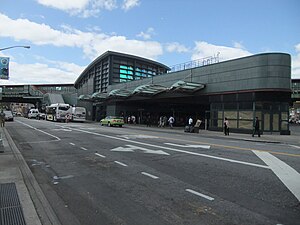Greenpoint and Roosevelt Avenues
 Roosevelt Avenue Bus Terminal in Jackson Heights | |
| Namesake | Greenpoint Bluff Theodore and Franklin D. Roosevelt |
|---|---|
| Owner | City of New York |
| Maintained by | NYCDOT |
| Length | 8.3 mi (13.4 km)[1] 2.4 mi (3.86 km) as Greenpoint Avenue 5.9 mi (9.50 km) as Roosevelt Avenue |
| Location | Brooklyn, Queens |
| Postal code | 11222, 11101, 11104, 11377, 11372, 11373, 11368, 11354 |
| Nearest metro station | Greenpoint Avenue Flushing Line Roosevelt/74th |
| West end | West Street in Greenpoint |
| Major junctions | |
| East end | |
Roosevelt Avenue and Greenpoint Avenue are main thoroughfares in the New York City boroughs of Queens and Brooklyn. Roosevelt Avenue begins at 48th Street and Queens Boulevard in the neighborhood of Sunnyside. West of Queens Boulevard, the road is named Greenpoint Avenue and continues through Sunnyside and Long Island City across the Greenpoint Avenue Bridge into the borough of Brooklyn, terminating at WNYC Transmitter Park on the East River in the neighborhood of Greenpoint.[2] Roosevelt Avenue goes through Woodside, Jackson Heights, Elmhurst, Corona, Flushing Meadows–Corona Park (adjacent to Citi Field) and Flushing. In Flushing, Roosevelt Avenue ends at 156th Street and Northern Boulevard.[1]
The 7 and <7> trains run on the elevated IRT Flushing Line tracks above the street with ten stations until it reaches Flushing – Main Street, its eastern terminus.[3] The rail line opened in 1917, when Roosevelt Avenue was formed from the combination of other streets into one main avenue.[4][5] The street, itself named after Theodore Roosevelt and Franklin D. Roosevelt,[5] provides the name for the Roosevelt Avenue / 74th Street station (7, <7>, E, F, <F>, M, and R trains) in Jackson Heights. The G train stops at the Greenpoint Avenue station located at Greenpoint Avenue and Manhattan Avenue. Roosevelt Avenue was nationally recognized for its cuisine when Good Magazine named it one of "America's Tastiest Streets".[6] Roosevelt Avenue is well known for its diversity of cultural representation, ranging from Indian to Latin American,[7] while in the 2020s, Downtown Flushing is undergoing rapid gentrification by Chinese transnational entities.[8]
Structures along the avenues include Eberhard Faber Pencil Factory on the western end of Greenpoint Avenue and the Newtown Creek Wastewater Treatment Plant just west of the Greenpoint Avenue Bridge. The eastern end of Roosevelt Avenue contains the Protestant Reformed Dutch Church of Flushing.
References
- ^ a b "Greenpoint and Roosevelt Avenues" (Map). Google Maps. Retrieved January 9, 2017.
- ^ "NYCDOT - Greenpoint Avenue Bridge over Newtown Creek". Archived from the original on 2010-02-21. Retrieved 2008-11-10.
- ^ Fernandez, Manny (2008-01-13). "Track Work Disrupts Service on No. 7 Train in Queens". The New York Times. ISSN 0362-4331. Archived from the original on 2020-03-30. Retrieved 2020-03-30.
- ^ Kilgannon, Corey (2005-12-21). "Under the Elevated Track, a New Sensation: Silence". The New York Times. ISSN 0362-4331. Archived from the original on 2020-03-30. Retrieved 2020-03-30.
- ^ a b Mbugua, Martin (August 3, 1999). "Make Tracks to Big Avenue". New York Daily News. Retrieved September 13, 2008.
- ^ Matthews, Adam (February 28, 2008). "America's Tastiest Streets". GOOD Magazine. Archived from the original on 2008-08-04.
- ^ "Queens for a Day". Village Voice. December 28, 1999. Retrieved November 21, 2022.
- ^ Ngu, Sarah (January 29, 2021). "'Not what it used to be': in New York, Flushing's Asian residents brace against gentrification". The Guardian US. Retrieved August 13, 2020.
The three developers have stressed in public hearings that they are not outsiders to Flushing, which is 69% Asian. 'They've been here, they live here, they work here, they've invested here,' said Ross Moskowitz, an attorney for the developers at a different public hearing in February...Tangram Tower, a luxury mixed-use development built by F&T. Last year, prices for two-bedroom apartments started at $1.15m...The influx of transnational capital and rise of luxury developments in Flushing has displaced longtime immigrant residents and small business owners, as well as disrupted its cultural and culinary landscape. These changes follow the familiar script of gentrification, but with a change of actors: it is Chinese American developers and wealthy Chinese immigrants who are gentrifying this working-class neighborhood, which is majority Chinese.
